![]() H. Christine Hsu Chsu@csuchico.edu is a Professor of Finance,
College of Business, California State University, Chico. H. Jeffrey Wei Jeffwei77@aol.com
is a co-founder of FASCO International Inc.
H. Christine Hsu Chsu@csuchico.edu is a Professor of Finance,
College of Business, California State University, Chico. H. Jeffrey Wei Jeffwei77@aol.com
is a co-founder of FASCO International Inc.
|
ABSTRACT The conventional wisdom of combining a relatively small number of stocks to achieve sufficient diversification may be misleading, as the benefit of diversification is measured in terms of the reduction in the standard deviation of portfolio returns across time. Long-term investors with specific investment goals such as retirement or college savings are concerned with the expected terminal period wealth and the dispersion of terminal wealth rather than the ups and downs of stock performance during the holding period. Although "terminal wealth dispersion" is a superior risk measure for investors with fixed investment goals, the use of this risk measure in financial research is somewhat limited. This paper provides some of the first empirical evidence on the impact of portfolio size / holding period on the dispersion of terminal wealth available to investors in the US equity market.
|
INTRODUCTION
Diversification reduces risk. It is well known that the firm's unique risks, such as the uncertainty of a firm's common stock performance resulting from workers striking, a change of management team, a lawsuit, an R&D breakthrough, downsizing, etc., can be diversified away through combining a relatively small number of stocks randomly selected from different sectors of industry. For example, Evans and Archer (1968) showed that portfolios with only 10 stocks have about the same amount of risk as that of the market portfolio. Tole (1982) suggested that the number is between 25 and 40. Statman (1987) included a risk-free asset in the analysis and reported that a well-diversified portfolio must include at least 30 stocks for a borrowing investor and 40 stocks for a lending investor.1 Unfortunately, all these studies use the standard deviation of portfolio returns over time to measure the variability of investment returns, and the benefit of stock diversification is measured in terms of the reduction in this time-series standard deviation of portfolio returns. Whereas this conventional risk measure is important to frequent traders aiming for short-run capital gains in the stock market, it is not as important to long-term investors with fixed obligations and/or savings goals. This is because holding the portfolios with small time-series standard deviations is no guarantee that the investment goals will be achieved at the time when the portfolios are liquidated.2 To institutional investors (e.g., pension funds and insurance companies) and individual investors with fixed investment time horizons and predetermined goals such as retirement or college savings, the expected portfolio value at the terminal period of the investment is much more important than the ups and downs of the portfolio returns during the holding period.
The standard deviation of terminal wealth (TWSD) is proposed by Radcliffe (1994) to measure the spread of terminal wealth available to investors with long-term goals. Terminal wealth is the expected portfolio value at the end of the investment horizon, and TWSD measures the dispersion of terminal wealth. Although terminal wealth dispersion is a superior risk measure for investors with fixed investment goals, financial studies employing this risk measure are limited to the UK property market and the US mutual fund market. Specifically, Lee and Byrne (2002) compared the potential benefits and limitations of risk reduction, as measured by both the terminal wealth dispersion and the time-series standard deviation in the UK property market over the period from 1981 to 1996, and they concluded that value-weighted portfolios generally offer greater rewards in the long run, but at the cost of significantly greater terminal wealth dispersion. O'Neal (1997) demonstrated that portfolios with as few as four growth mutual funds halve the dispersion in terminal wealth for 5- to 19-year holding periods beginning in 1976 and ending in 1994.
To shed some light on the benefit of diversification for long-term investors with predetermined investment goals in the US stock market, this study investigates the impact of portfolio size / holding period on the dispersion of terminal wealth available to the investors. The purpose is to provide some guidelines in formulating stock portfolios to accomplish adequate diversification in a volatile stock market. The focus is on risk diversification as measured in terms of the reduction in terminal wealth dispersion of common stock portfolios, which is not yet documented in the financial literature.
DATA AND SIMULATION
The sampling procedure starts with all 1,500 US firms in the S&P Super Composite index as of March 2003. The index is composed of firms in the S&P Big Cap 500, the S&P Mid Cap 400, and the S&P Small Cap 600. The price and dividend data of each firm are collected from the common stock database provided by Commodity Systems Inc., and the total returns of the S&P 500 index are from Standard and Poor's, a division of the McGraw-Hill Companies, Inc. Firms with inactive trading records or incomplete price and dividend data for the period from January 1993 to December 2002 are excluded from the sample, which leaves us with 1068 firms for the study.
The annual total return on a firm's common stock is computed as the sum of dividend yield [= annual dividend/beginning price of the stock] and capital gains yield [= (ending price of the stock - beginning price of the stock)/ beginning price of the stock]. The value of a stock at the end of the investment horizon is calculated by compounding its annual returns over the holding periods. For example, if the total returns on a stock in years 1, 2 and 3 are 15%, 12% and -8%, respectively, then the terminal value of the stock at the end of the 3-year holding period equals 1.185 x beginning stock price [= (1.15) x (1.12) x (.92) x beginning stock price]. The level of terminal period wealth depends on the stocks included in the portfolio as well as the length of the holding period. It is expected that the investors holding the same stock portfolio for different investment horizons are rewarded different terminal wealth; so are the investors holding different stock portfolios for the same investment horizon. Sufficiently reducing the dispersion of terminal wealth is of direct relevance to investors with fixed long-term obligations and/or savings goals.
To investigate how terminal wealth dispersion can be reduced, this study employs Radcliffe's (1994) "terminal wealth standard deviation" to measure the dispersion of the terminal wealth resulting from thousands of simulated portfolio investments. To determine the terminal wealth dispersion of the portfolio, a simulation procedure similar to that of O'Neal (1997) is applied:
The simulation is repeated 1,000 times for each n-stock portfolio with t-year holding period. The terminal wealth mean (dispersion) is then calculated as the average (standard deviation) of the 1,000 terminal wealth generated in the simulations for each investment. The terminal wealth mean (TW) measures the terminal value of the investment, while the terminal wealth standard deviation (TWSD) measures the dispersion of the terminal wealth levels faced by the investor for each investment in an n-stock portfolio for t years. Investors are aiming for greater rewards, measured in terms of terminal wealth means, but smaller risk, measured in terms of terminal wealth standard deviations. In other words, it is desirable to reduce the terminal wealth coefficient of variation (TWCV = TWSD / TW) that measures terminal wealth dispersion per dollar of terminal wealth.
SIMULATION RESULTS
Table 1 and Chart 1 summarize the simulation results for the terminal wealth means of the sample portfolios along with the performance of the S&P 500 index. It is clear from Table 1 (Chart 1) that given each investment horizon studied, there is virtually no difference in the terminal wealth across all n-stock portfolios; the difference between the terminal wealth means of any two n-stock portfolios is not statistically significant (n = 10, 20, 30, 40, 50, 60, 70). However, there is a positive relationship between the level of terminal wealth and the length of the investment horizon over the study periods: the investors' terminal wealth is maximized (minimized) if the portfolios are held for 10 (3) years. In other words, the longer the holding period, the higher is the terminal wealth available to the investors liquidating at the end of December 2002. For example, the terminal wealth increased from $1.19 million to $3.746 million if investors invested one million dollars in 50-stock portfolios at the beginning of January 1993 instead of January 2000. For the investments in the S&P 500, the one million dollars invested at the beginning of January 2000 are worth only $0.624 million, while the one million dollars invested at the beginning of January 1993 are worth $2.443 million at the end of December 2002. This is not at all surprising as we look back at the stock market in the past ten years. The long lasting bull market reached its peak in March 2000, and the bear market followed thereafter. Since all portfolios were sold in the bear market at the end of December 2002, investors were much better off if they purchased the portfolios earlier, rather than later during our study period. The terminal wealth to the investors with a three-year holding period in this study is the lowest among all t-year holding periods (t = 3, 5, 8, 10) because they entered the market in January 2000 when the market is very close to its peak.
TABLE 1. TERMINAL WEALTH MEANS OF THE SIMULATED PORTFOLIOS AND THE S&P 500 BY HOLDING PERIODS (figures in $ millions)
| Holding Period | 10-STK | 20-STK | 30-STK | 40-STK | 50-STK | 60-STK | 70-STK | S&P 500 |
| 1/00 -12/02 | 1.181 | 1.176 | 1.187 | 1.187 | 1.190 | 1.183 | 1.188 | 0.624 |
| 1/98 -12/02 | 1.299 | 1.288 | 1.293 | 1.299 | 1.301 | 1.296 | 1.302 | 0.971 |
| 1/95 -12/02 | 3.059 | 3.060 | 3.105 | 3.141 | 3.106 | 3.049 | 3.101 | 2.191 |
| 1/93 -12/02 | 3.723 | 3.649 | 3.652 | 3.732 | 3.746 | 3.661 | 3.698 | 2.443 |
CHART 1. THE RELATIONSHIP BETWEEN PORTFOLIO SIZE AND TERMINAL WEALTH MEAN
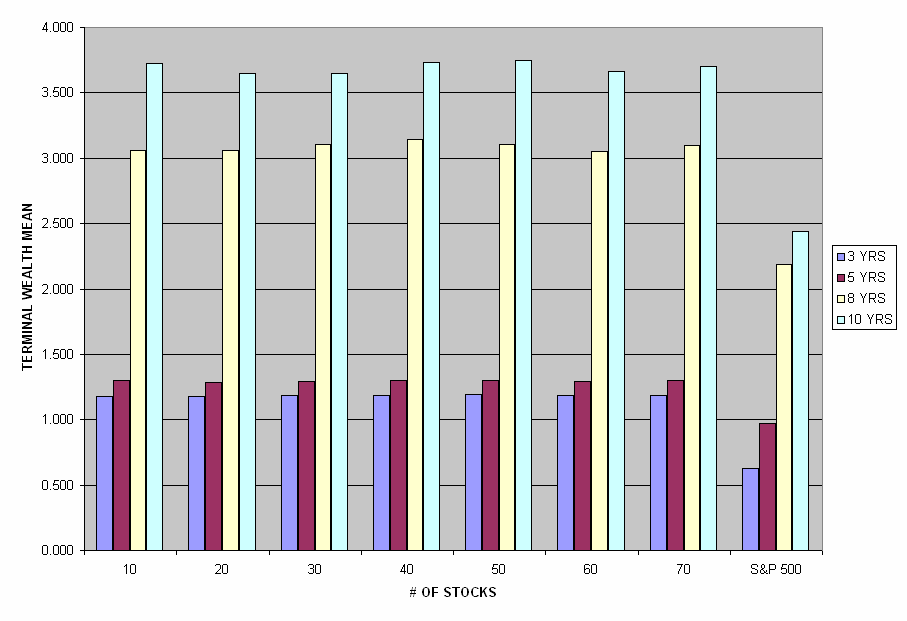
It is also evident from Table 1 (Chart 1) that the sample portfolios outperform the S&P 500 in every holding period studied. Table 2 shows the excess terminal wealth created from the sample portfolios, i.e., the difference between the terminal wealth of the sample portfolios and that of the S&P 500 in each holding period. It is interesting to point out that given the 3 (10)-year holding period, our sample portfolios beat the S&P 500 by more than $0.55 ($1.2) million. The excess terminal wealth generated from the sample portfolios is statistically significant at .001 level from t-tests for all n-stock portfolios (n = 10, 20, 30, 40, 50, 60, 70) with any t-year holding period (t = 3, 5, 8, 10). One possible explanation for the superior performance of the sample portfolios is the fact that the sample portfolios include firms of different market capitalization while the S&P 500 includes only big capitalization firms.3 The investment implication is that investors could beat the market (as approximated by the S&P 500) if they invest in the portfolios composed of not only big-cap but mid-cap and small-cap stocks as well. Clearly, the excess terminal wealth created from the sample portfolios is not by chance.
TABLE 2. EXCESS TERMINAL WEALTH OF THE SIMULATED PORTFOLIOS BY HOLDING PERIODS (figures in $ millions)
| Holding Period | 10-STK | 20-STK | 30-STK | 40-STK | 50-STK | 60-STK | 70-STK |
| 1/00 -12/02 | 0.557 | 0.552 | 0.563 | 0.563 | 0.566 | 0.559 | 0.564 |
| Significance level | *** | *** | *** | *** | *** | *** | *** |
| 1/98 -12/02 | 0.328 | 0.317 | 0.322 | 0.328 | 0.330 | 0.325 | 0.331 |
| Significance level | *** | *** | *** | *** | *** | *** | *** |
| 1/95 -12/02 | 0.868 | 0.869 | 0.914 | 0.950 | 0.915 | 0.858 | 0.910 |
| Significance level | *** | *** | *** | *** | *** | *** | *** |
| 1/93 -12/02 | 1.280 | 1.206 | 1.209 | 1.289 | 1.302 | 1.218 | 1.255 |
| Significance level | *** | *** | *** | *** | *** | *** | *** |
Although the terminal wealth means of the sample portfolios are desirable to investors as compared to the performance of the S&P 500, there is obviously a great deal of uncertainty in the realized terminal wealth at the end of the investment. It is important to know if this dispersion of terminal period wealth can be adequately reduced by adding stocks to the portfolios. We now turn to risk diversification and the dispersion of terminal period wealth. The important question is: how many stocks are needed to achieve sufficient risk reduction in terminal wealth?
Recall that the dispersion of the terminal wealth is measured in terms of the standard deviation of the 1,000 simulated terminal period wealth in each investment with n-stock portfolio (n = 10, 20, 30, 40, 50, 60, 70) for t years (t = 3, 5, 8, 10). Table 3 and Chart 2 present the standard deviations of the simulated portfolios by holding periods. As is shown in Table 3, the terminal wealth standard deviation of the 10-stock portfolios is substantial, ranging from $.234 million to $1.613 million. Notice that the TWSD of the portfolios decreases as the portfolio size increases. Given the holding period from January 2000 to December 2002, for example, the TWSD is down from $.234 million to $0.089 million as the number of stocks in the portfolios is increased from 10 to 70. From F-tests, the decline in the terminal wealth variance (= TWSD2) resulting from adding 10 more stocks to the n-stock portfolios (n = 10, 20, 30, 40, 50, 60) is statistically significant for most investments; the significance level is at .001 for all holding periods when 10 more stocks are added to either 10-stock or 20-stock portfolios. In addition, Table 3 and Chart 2 suggest that there is a positive relationship between the dispersion of terminal wealth and the length of the investment horizon. The standard deviation of the terminal wealth is the smallest (highest) when the portfolios are held for 3 (10) years over the sample period. This contradicts the general perception that the longer the holding period, the smaller the risk of the investment. The generally accepted negative relationship between the length of the investment horizon and the risk of the investment exists when the risk is measured in terms of the standard deviation of portfolio returns over time; the longer the holding period the smaller the time-series standard deviation of portfolio returns. However, when the terminal wealth dispersion is used to measure the risk of the investment, this generally accepted relationship no longer holds. The longer the investment horizon, the greater the uncertainty regarding the terminal value of the investment. This is because greater uncertainty is associated with the ultimate outcome of the investment as investors commit their capital in the stock market for a longer period of time. Nonetheless, investors are rewarded for bearing this risk. Chart 3 depicts the risk-reward relationship of the portfolio investments; the longer the holding period, the greater the terminal wealth, but also the greater the dispersion of the terminal wealth, and vice versa. It is expected that a rational investor prefers the portfolio with the highest possible reward (terminal wealth) given a certain level of risk (terminal wealth standard deviation) or the portfolio with the smallest possible risk (terminal wealth standard deviation) given a certain amount of reward (terminal wealth). The portfolios with optimal risk-reward combinations are highlighted (with a mark x) in Chart 3; they are the 70-stock portfolios held for 3, 5, 8 and 10 years.
CHART 2. THE RELATIONSHIP BETWEEN PORTFOLIO SIZE AND TERMINAL WEALTH STANDARD DEVIATION
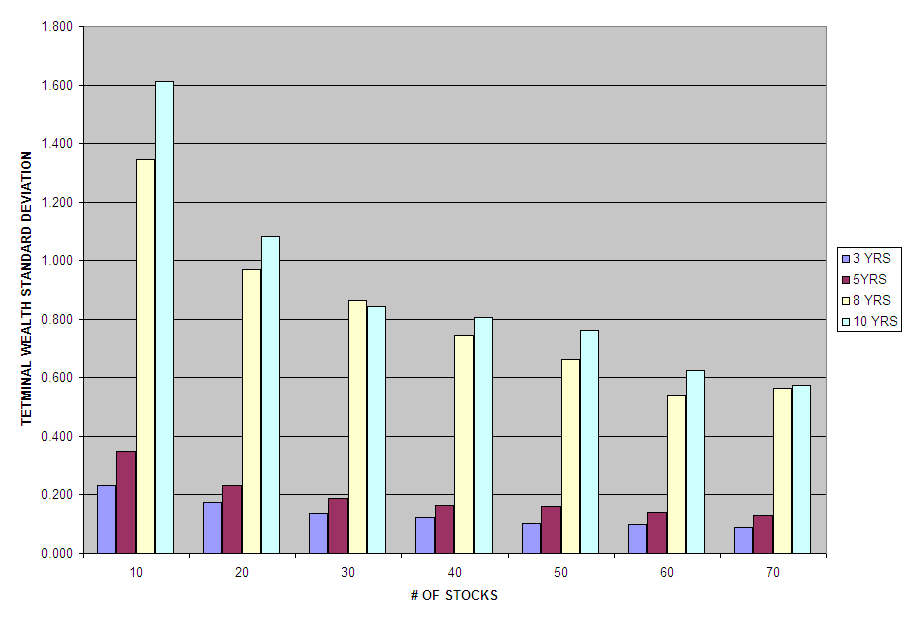
TABLE 3. TERMINAL WEALTH STANDARD DEVIATIONS OF THE SIMULATED PORTFOLIOS BY HOLDING PERIODS (figures in $ millions)
| Holding Period | 10-STK | 20-STK | 30-STK | 40-STK | 50-STK | 60-STK | 70-STK |
| 1/00 -12/02 | 0.234 | 0.174 | 0.135 | 0.122 | 0.102 | 0.100 | 0.089 |
| Significance level | . | *** | *** | *** | *** | . | *** |
| 1/98 -12/02 | 0.348 | 0.234 | 0.188 | 0.164 | 0.159 | 0.138 | 0.131 |
| Significance level | . | *** | *** | *** | . | *** | * |
| 1/95 -12/02 | 1.344 | 0.971 | 0.865 | 0.745 | 0.662 | 0.540 | 0.563 |
| Significance level | . | *** | *** | *** | *** | *** | . |
| 1/93 -12/02 | 1.613 | 1.083 | 0.842 | 0.805 | 0.763 | 0.624 | 0.574 |
| Significance level | . | *** | *** | . | * | *** | ** |
CHART 3. THE RISK-REWARD RELATIONSHIP OF THE SIMULATED PORTFOLIOS BY HOLDING PERIODS
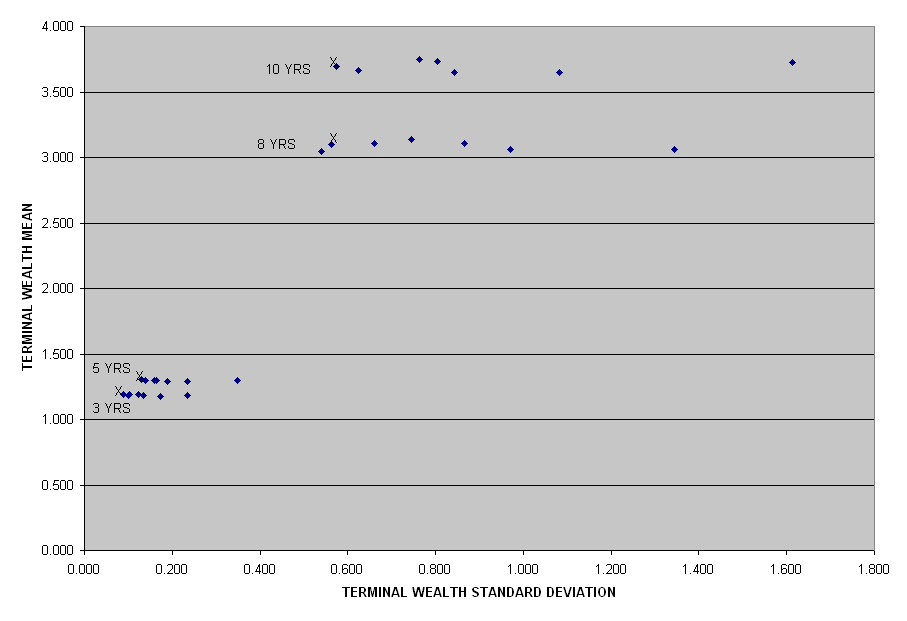
To better capture the risk-reward attributes of the simulated portfolios, the terminal wealth coefficients of variation (TWCV = TWSD / TW) are tabulated in Table 4 and plotted in Chart 4. TWCV is a relative risk measure; it measures the terminal wealth dispersion per dollar of terminal wealth. As is shown in Table 4 (Chart 4), the TWCV decreases with portfolio size. The investment implication is that terminal wealth dispersion can be reduced through increasing the number of stocks in the portfolio. In addition, given portfolio size, the TWCV is relatively smaller when the portfolios are held for three or five years, but larger when held for eight or ten years. Generally speaking, it is desirable to reduce TWCV because rational investors are risk averse. However, not all investors have the same degree of risk aversion. Different investors have different tolerance for risk. Given an investor's desired risk characteristics, optimal portfolio strategies can be formulated by adjusting the length of the holding period and/or the number of stocks in the portfolios to meet the desired risk profiles. The general guideline is that investors need to increase the portfolio size and/or shorten the investment horizon to reduce TWCV. In our study, for example, the investors with very low risk tolerance should invest in the 70-stock portfolios with a three-year holding period.
TABLE 4. TERMINAL WEALTH COEFFICIENTS OF VARIATION OF THE SIMULATED PORTFOLIOS BY HOLDING PERIODS
| Holding Period | 10-STK | 20-STK | 30-STK | 40-STK | 50-STK | 60-STK | 70-STK |
| 1/00 -12/02 | 0.198 | 0.148 | 0.114 | 0.103 | 0.086 | 0.085 | 0.075 |
| 1/98 -12/02 | 0.268 | 0.182 | 0.145 | 0.126 | 0.122 | 0.106 | 0.101 |
| 1/95 -12/02 | 0.439 | 0.317 | 0.279 | 0.237 | 0.213 | 0.177 | 0.182 |
| 1/93 -12/02 | 0.433 | 0.297 | 0.231 | 0.216 | 0.204 | 0.170 | 0.155 |
CHART 4. THE RELATIONSHIP BETWEEN PORTFOLIO SIZE AND TERMINAL WEALTH COEFFICIENT OF VARIATION
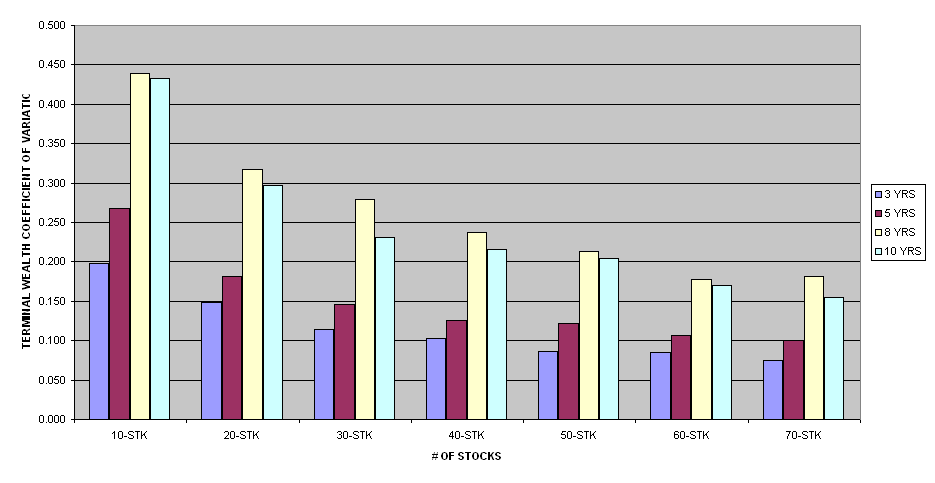
To further investigate the risk reduction effect across different n-stock portfolios, we standardize the TWCV of each portfolio by dividing it by the TWCV of the 10-stock portfolios in each holding period. That is, the 10-stock portfolios are treated as the baseline portfolios and the TWCV of all other portfolios are expressed as percentages of the baseline TWCV in each investment horizon. Table 5 and Chart 5 summarize the results. We find that the dispersion of terminal wealth is cut by more than 25 percent when the portfolio size is increased from 10 to 20 stocks and by more than 50 percent from 10 to 50 stocks in each holding period. The benefit of risk diversification is somewhat trivial when the number of stocks in the portfolio goes beyond 50. The investment implications are that investors can reduce terminal wealth dispersion by adding stocks to the portfolios and that they need to have at least 50 randomly selected stocks in their portfolios in order to reduce the terminal wealth dispersion by half.
TABLE 5. TERMINAL WEALTH COEFFICIENTS OF VARIATION OF THE SIMULATED PORTFOLIOS BY HOLDING PERIODS (figures as % of terminal wealth coefficient of variation of 10-stock portfolios in each holding period)
| Holding Period | 10-STK | 20-STK | 30-STK | 40-STK | 50-STK | 60-STK | 70-STK |
| 1/00 -12/02 | 100.0% | 74.7% | 57.4% | 51.9% | 43.3% | 42.7% | 37.8% |
| 1/98 -12/02 | 100.0% | 67.8% | 54.3% | 47.1% | 45.6% | 39.7% | 37.6% |
| 1/95 -12/02 | 100.0% | 72.2% | 63.4% | 54.0% | 48.5% | 40.3% | 41.3% |
| 1/93 -12/02 | 100.0% | 68.5% | 53.2% | 49.8% | 47.0% | 39.3% | 35.8% |
CHART 5. THE RELATIONSHIP BETWEEN PORTFOLIO SIZE AND TERMINAL WEALTH COEFFICIENT OF VARIATION (figures as % of terminal wealth coefficient of variation of 10-stock portfolios in each holding period)
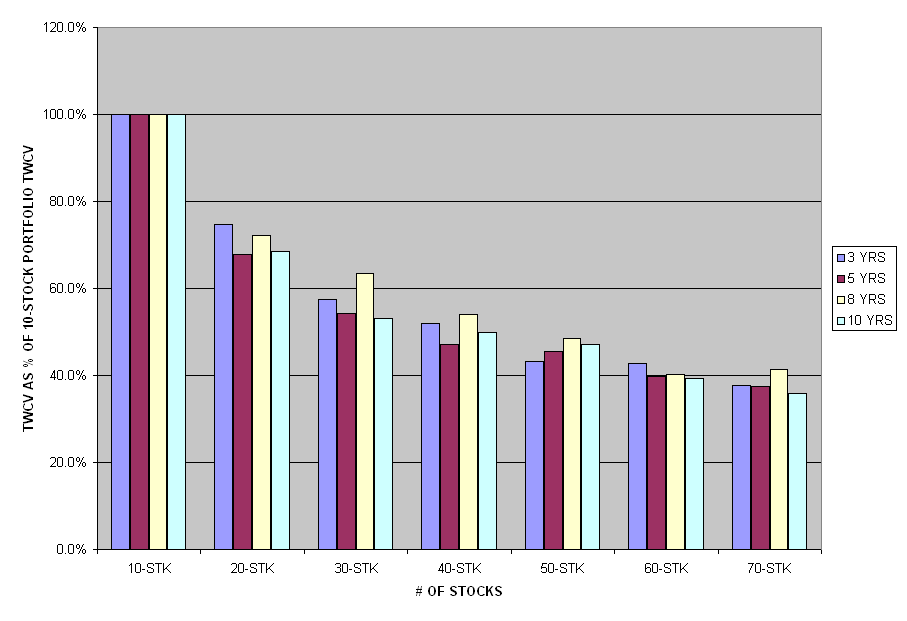
To sum up, the terminal wealth increases as the length of holding period increases over our study periods, and terminal wealth dispersion increases with the length of holding period and declines with the portfolio size. Demonstrated is that diversification reduces the terminal wealth dispersion sharply at first and then slowly as the number of stocks in the portfolio goes beyond 50. Keep in mind that the results reported in this section are from simulated portfolio investments ending in a bear market in December 2002. An interesting question emerges: what if the portfolios are liquidated in a bull market? To answer this question, simulations were run for each n-stock portfolio (n = 10, 20, 30, 40, 50, 60, 70) held for t years (t = 3, 5, 7) until the end of December 1999.4 The simulation results are presented in Appendix B. As shown in Charts 1A - 5A in Appendix B, the results are very similar to the findings here in this section.
CONCLUSIONS
Our research highlights the inherent limitation of the conventional risk measure and uses terminal wealth dispersion to examine the benefit of risk diversification in the US stock market. The conventional wisdom of combining a relatively small number of stocks to achieve adequate diversification may be misleading. For long-term investors with fixed obligations and/or savings goals, the number of stocks needed to accomplish sufficient diversification is much larger than suggested in the literature. Demonstrated is that the dispersion of terminal wealth is cut by more than 25 percent when the portfolio size is increased from 10 to 20 stocks and by more than 50 percent from 10 to 50 stocks in each holding period studied. The benefit of risk diversification is somewhat limited when the number of stocks in the portfolio goes beyond 50. The simulation presented here suggests that the number of stocks needed to form a diversified portfolio of common stocks be at least 50 in the US equity market, and that investors with relatively high degree of risk aversion should hold more than 50 stocks in their portfolios.
In contrast to the general perception that the longer the holding period, the smaller the risk of the investment, shown in this article is a positive relationship between the dispersion of terminal wealth and the length of the holding period, and that the dispersion of terminal wealth increases as the investment time horizon increases. This is because greater uncertainty is associated with the ultimate outcome of the investment as the investors commit their capital in the US stock market for a longer period of time. Nonetheless, investors are rewarded for bearing this risk, and the longer the holding period, the greater the terminal period wealth. Given an investor's desired risk characteristics, optimal portfolio strategies can be formulated by adjusting the length of the holding period and/or the number of stocks in the portfolio to meet the desired risk profiles. For example, an investor with relatively low risk tolerance should increase the portfolio size and/or shorten the investment horizon to reduce the terminal wealth dispersion. Furthermore, shown is that our sample portfolios outperform the S&P 500 in all holding periods studied, and the excess terminal wealth is statistically significant. The investment implication is that investors should diversify across different market capitalization stocks instead of investing exclusively in the S&P 500 big-cap stocks.
As investing in the stock market has become an integral part of asset allocation in financial planning for many long-term investors, it is hoped that the results reported here may help investors in their portfolio strategies and risk management in the US stock market.
To demonstrate the inherent limitation of the conventional risk measure, it is assumed that an investor invests one million dollars in a portfolio consisting of stocks A and B and holds the portfolio for three years. We also assume the following:
It is clear that combining stocks A and B eliminates the variability of the portfolio returns across time, and the standard deviation of the portfolio returns (the conventional risk measure) is zero over the 3-year investment horizon. However, the terminal period wealth available to the investor is below the initial investment of $1 million:
As is shown in the example, the investor investing in the portfolio with zero time-series standard deviation of portfolio returns during the entire holding periods is still subject to great uncertainty regarding the terminal period wealth.
To determine the terminal wealth dispersion of the portfolio, the following simulation analysis is performed:
The simulation is repeated 1,000 times for each n-stock portfolio with t-year holding period. The terminal wealth means, standard deviations, and coefficients of variation of the simulated portfolios are presented, by holding periods, in Chart 1A, 2A and 4A, respectively. Chart 3A evinces the risk-reward relationships of the portfolios. Chart 5A shows the terminal wealth coefficients of variation of the portfolios expressed as percentages of the10-stock portfolios coefficient of variation in each holding period.
CHART 1A. THE RELATIONSHIP BETWEEN PORTFOLIO SIZE AND TERMINAL WEALTH MEAN
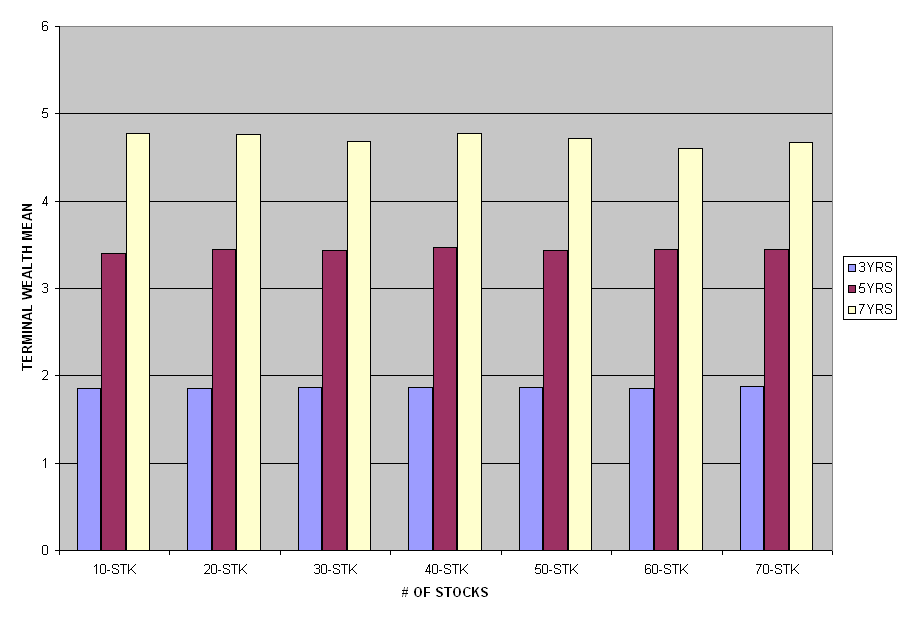
Chart 1A confirms that there is no relationship between the number of stocks in the portfolios and the terminal wealth mean of the simulated portfolios. However, the positive relationship between the length of the holding period and the terminal wealth of the portfolios is observed.
CHART 2A. THE RELATIONSHIP BETWEEN PORTFOLIO SIZE AND TERMINAL WEALTH STANDARD DEVIATION
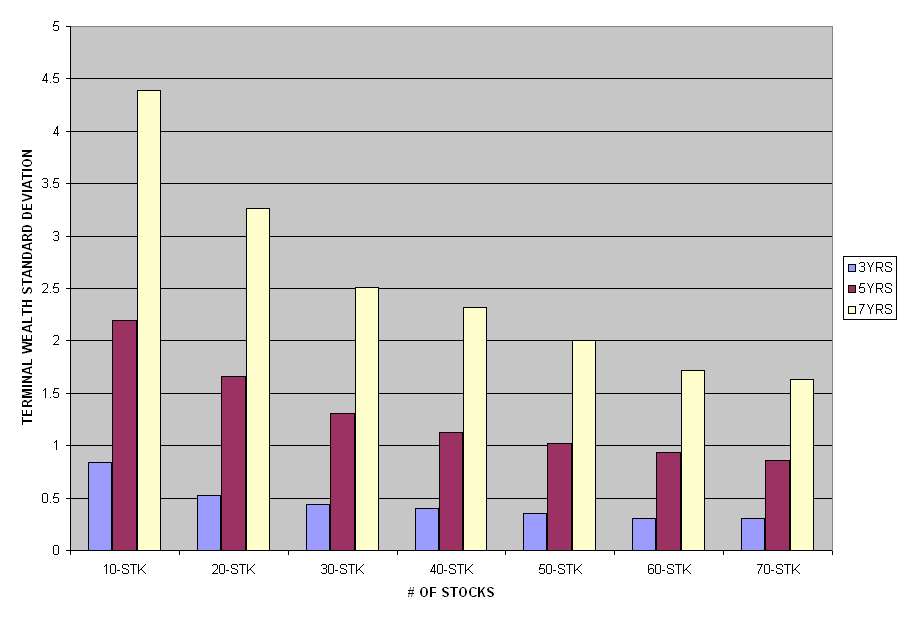
It is confirmed that the terminal wealth dispersion as measured in term of terminal wealth standard deviation (TWSD) decreases with the number of stocks in the portfolios. Moreover, the positive relationship between the length of the holding period and TWSD is also observed for the simulated portfolios.
CHART 3A. THE RISK-REWARD RELATIONSHIP OF THE SIMULATED PORTFOLIOS BY HOLDING PERIODS
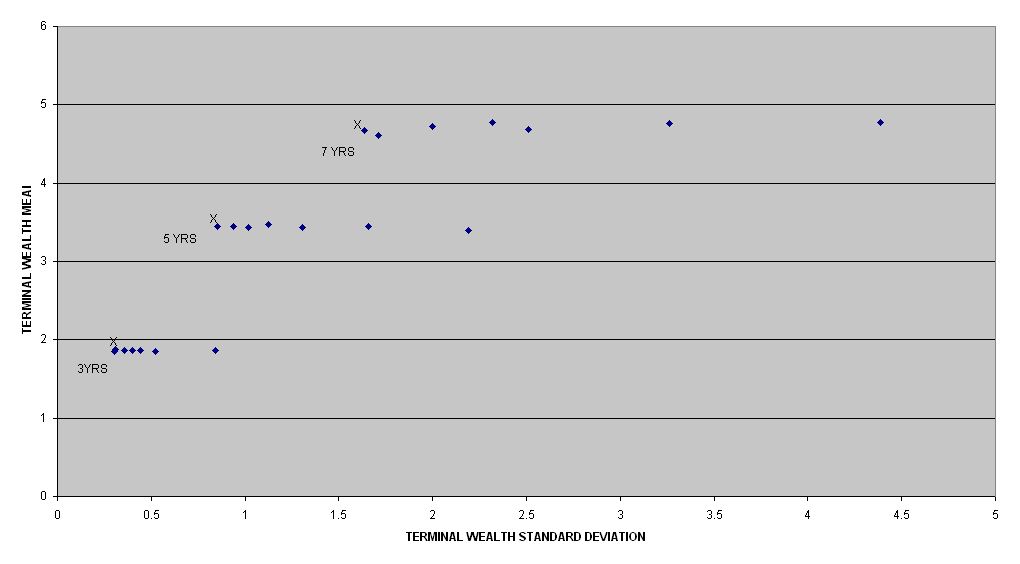
Chart 3A confirms the risk-reward tradeoffs in the stock portfolio investments; the longer the holding period, the greater the terminal wealth but the greater the dispersion of the terminal wealth, and vice versa. The optimal portfolios highlighted with a mark x in the Chart are the 60-stock portfolios held for three years and the 70-stock portfolios held for five and seven years.
CHART 4A. THE RELATIONSHIP BETWEEN PORTFOLIO SIZE AND TERMINAL WEALTH COEFFICIENT OF VARIATION
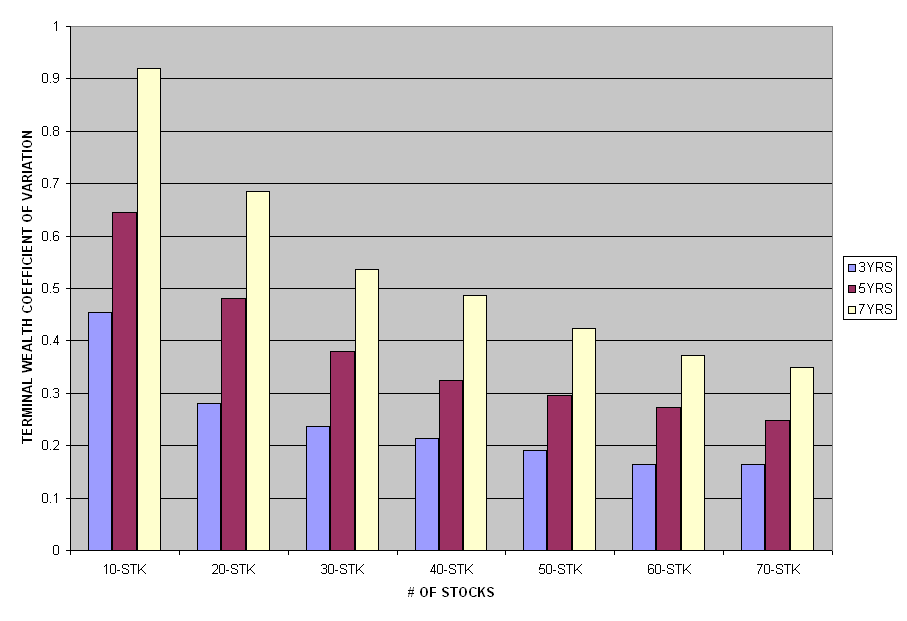
It is confirmed that the terminal wealth dispersion as measured in term of terminal wealth coefficient of variation (TWCV) decreases with the portfolio size but increases with the length of the holding period.
CHART 5A. THE RELATIONSHIP BETWEEN PORTFOLIO SIZE AND TERMINAL WEALTH COEFFICIENT OF VARIATION (figures as % of terminal wealth coefficient of variation of 10-stock portfolios in each holding period)
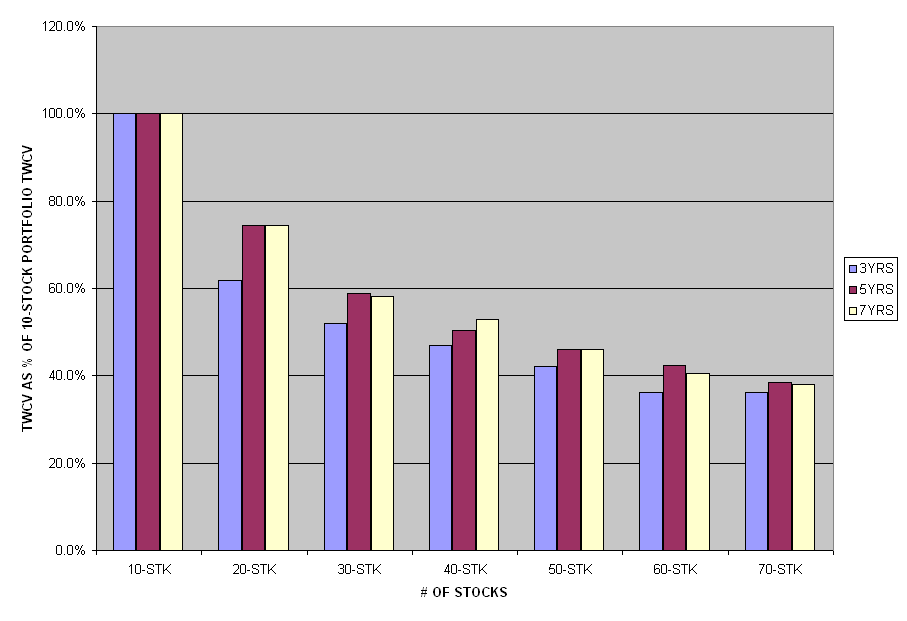
It is confirmed that the terminal wealth dispersion declines sharply at first when additional stocks are added to the 10-stock portfolios, and it tails off when the number of stocks in the portfolios goes beyond 50. The dispersion of terminal wealth is cut by more than 25 percent when the portfolio size is increased from 10 to 20 stocks and by more than 50 percent from 10 to 50 stocks in each holding period.
ENDNOTES
1. A lending investor invests in both the risk-free asset and the stocks, while a borrowing investor short sells the risk-free asset and invests the proceeds plus his/her own capital in the stocks.
2. See Appendix A for a simple example illustrating the inherent limitation of the conventional risk measure.
3. Empirical studies find that small capitalization stocks earn higher mean returns than big capitalization stocks, see for example, Banz (1981), Chan and Chen (1991), Fama and French (1992, 1995), among others.
4. Given the sample period from January 1993 to December 2002, the longest possible holding period for the simulated investments ending in December 1999 is 7 years.
REFERENCES
Banz, R. W., "The relationships between return and market value of common stocks." Journal of Financial Economics (1981): 3-18.
Chan, K. C. and N. Chen, "Structural and return characteristics of small and large firms." Journal of Finance (September 1991): 1467-1484.
Evans, J. L., and S. H. Archer, "Diversification and the reduction of dispersion: an empirical analysis" Journal of Finance (December 1968): 761-767.
Fama, E. F. and K. R. French, "The cross-section of expected stock returns." Journal of Finance (June 1992): 427-465.
Fama, E. F. and K. R. French, "Size and book-to-market factors in earnings and returns." Journal of Finance (March 1995): 131-155.
Lee, S. and P. Byrne, "The impact of portfolio size on the variability of the terminal wealth of real estate funds." Briefings in Real Estate Finance (February 2002): 319-330.
O'Neal, E. S. "How many mutual funds constitute a diversified mutual fund portfolio?" Financial Analysts Journal (March/April 1997): 37-46.
Radcliffe, R. C. Investment: Concepts, Analysis, Strategy. New York: Harper Collins College Publishers (1994).
Statman, M. "How many stocks make a diversified portfolio?" Journal of Financial and Quantitative Analysis (September 1987): 353-363.
Tole, T. "You can't diversify without diversifying."
Journal of Portfolio Management (1982): 5-11.
B>Quest
(Business Quest)
A Web Journal of Applied Topics in Business and Economics